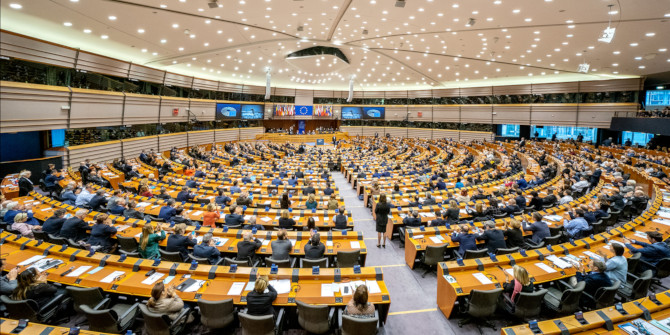The gender gap pervades almost all aspects of the academic world. Drawing on a recent co-authored study, Julia Bettecken and Gerald Schneider show the imbalance is also present at the journal European Union Politics (EUP). The gap at EUP manifests itself not only in the underrepresentation of females as editors, authors, or reviewers, but also in their correspondence with the editorial office.
“Here, there, everywhere” is one of the lesser known songs of the Beatles. The title is also an apt description of one of the persistent problems of social life. Women still earn less than men in many professions, receive less recognition and are promoted less frequently than their counterparts. In academia, this imbalance finds its expression for instance in gaps between wages, citations, and tenured positions.
Together with Ann-Cathrin Klöckner and Charlotte Kurch, we examined whether such trends also hunt the academic journal European Union Politics (EUP). We have found considerable evidence that the situation has not or only slightly improved since the second half of the 2000s and thus the period for which we have the earliest data. In particular, we show that both female authors and reviewers are still underrepresented at EUP. However, women’s chances of having their articles accepted and their recommendations for submitted articles are comparable to those of their male colleagues.
We present three major results. First, women submit fewer papers. This overall trend in the field of political science and other disciplines is also paramount in the submissions to EUP: The share of female submitting authors has been approaching but never exceeding the 40% mark (see Figure 1a). Moreover, comparing the share of female submitting authors across time does not lead to any significant differences. Yet, while submitting authors still tend to be male, the share of mixed author teams is steadily increasing. At the same time, the observed decline in same-sex teams also stems from the decline in all-male submissions (see Figure 1b).
Figure 1: Submitting authors by gender over time (Figure 1a) and author team composition by gender over time (Figure 1b)
Note: Figure 1a shows the percentage of female and male authors. Figure 1b shows the percentage of submissions by female authors, male authors, and mixed authors. AUT: author(s).
Second, and unlike other studies, we cannot confirm that female submitting authors are favoured towards men when considering the final acceptance for publication. While we record a strong and significant decline in the acceptance of both female (by 27 percentage points) and male (by 34 percentage points) submitting authors, this development is not surprising, but rather indicative of the higher standard of scrutiny applied to cope with the growing number of submissions. When comparing acceptance rates by gender, the gap between male and female submitting authors has more than halved over the years, still amounting to five percentage points (in favour of male submitting authors) in 2019.
Finally, very similar patterns are observable for the peer review process. The share of female reviewers (around 30% in 2019) remained relatively stable across the period of observation, as did the share of all-female reviewer teams (i.e., females assigned to the same submission). While all-male reviewer teams still represented the largest share (44%) in 2019, the share of mixed reviewer teams has increased (plus five percentage points), partly compensating for the drop in all-male reviewer teams. These changes in the composition of reviewer teams, albeit insignificant, suggest a slow but steady change towards more female participation at both ends of the review process, thereby also reducing gender biases.
These results are in line with what has been established for other journals in the discipline. We believe that counter-actions to this depressing state of affairs are urgent – not least because the pandemic has increased the gender gap inside and outside of academia. To monitor and revert such trends, journal editorial boards should ask publishers to provide data on the gender balance in the different stages of article production on a regular basis.
We have examined whether the reported outcomes are associated with the use of language in the communication between authors and reviewers throughout EUP’s peer review process, including the following document types: cover letters, author responses, and reviews. On the one hand, the word count statistics reveal that female authors keep their cover letters and author responses to reviewer comments shorter than their male colleagues.
On the other hand, women use significantly more words when reviewing other authors’ work, suggesting that their male colleagues spent more time on the correspondence regarding their own work. Moreover, when assessing the choice of words, we show that females use more cautious and modest language in their correspondence with the editorial office. However, we do not find evidence that the use of language affects the outcome of the review process.
Taken together, the findings highlight that there is an urgent need for action. We believe that editors and scholarly organisations share the responsibility to address this issue. Potential reform measures should target all disadvantaged groups – junior researchers and female and minority scholars in particular. They should receive hands-on advice on how to write scientific prose and how to correspond with journals in a confident, but not overly aggressive manner. We also propose mentorships between editorial board members and junior scholars who might not have the ideal background to develop their professional careers.
These and similar arrangements could find the support of academic organisations, such as the European Consortium for Political Research or the European Political Science Association. Both organisations already offer training opportunities that could further be complemented by editors and editorial board members acting as talent and problem spotters in this regard.
For more information, see the authors’ accompanying paper (co-authored with Ann-Cathrin Klöckner and Charlotte Kurch) at European Political Science
Note: This article gives the views of the authors, not the position of EUROPP – European Politics and Policy or the London School of Economics. Featured image credit: CC-BY-4.0: © European Union 2021 – Source: EP






